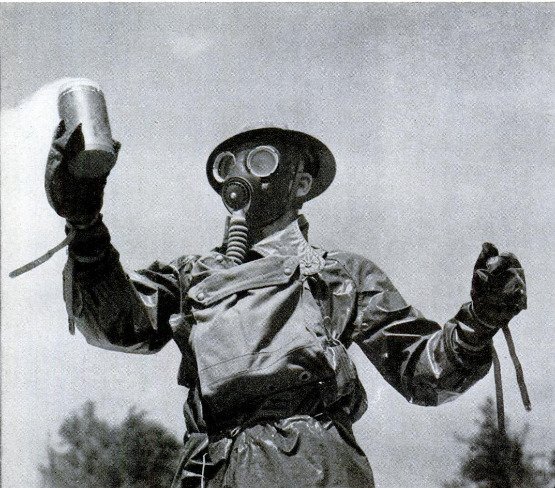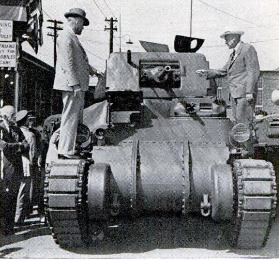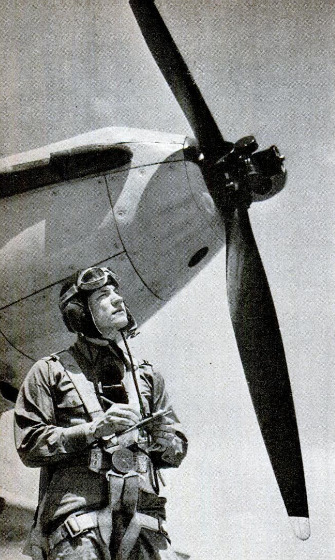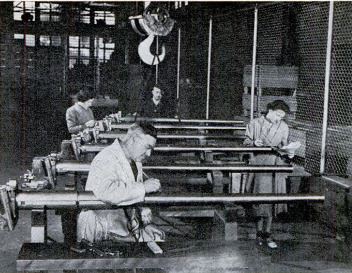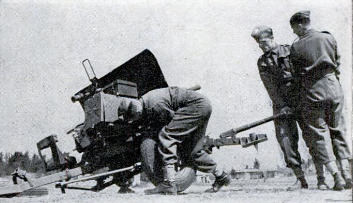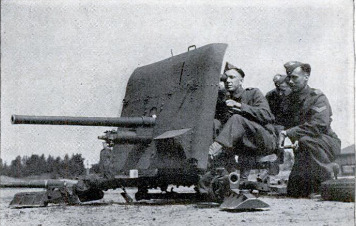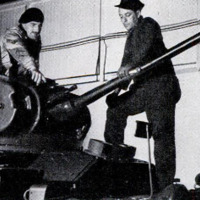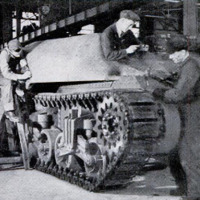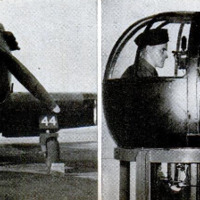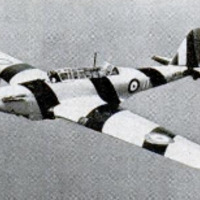-
Title (Dublin Core)
-
How Canada is fighting Hitler
-
Article Title and/or Image Caption (Dublin Core)
-
Title: How Canada is fighting Hitler
-
extracted text (Extract Text)
-
Beating her plowshares into swords, our neighbor pours man and materials into war
WITH less than one tenth the man-
power of the United States, Canada
has already thrown a decisive and
startling volume of military and indus-
trial power into the battle against Hitler.
Its army of 400,000, of whom 100,000 are in
England, is the largest in its history. Its
planes and pilots, which when they were few
fought savagely in the Battle of Britain,
today number more than 100,000 Air Force
personnel and thousands of planes. The
Navy, expanded more than ten times, main-
tains vigilant watch over the North Atlan-
tic. And finally, Canadian industry, rela-
tively small in 1939, today furnishes most
of the equipment for the Dominion’s own
armed forces, and within six months will
reach its production peak, a full year ahead
of the United States.
The transformation of the Dominion’s
economy from agricultural to industrial has
been a modern machine-age miracle. A na-
tion of farmers, trappers, miners, and
traders has turned into a nation of soldiers
and factory workers. During this fiscal year,
Canada is making a literal gift of 1% billion
dollars in war equipment to the Empire and
fully half of the Empire's air strength will
eventually come from the Dominion—two
reasons why every Canadian is giving up
almost one half of his income in taxes.
As aviation-minded as any people on
earth, the Canadians have made their most
conspicuous war effort in the air. At the
beginning of the war, the Dominion’s air-
craft industry was very small. This year
its production has approached 200 planes a
month—bombers, fighters, and trainers—
and it still is increasing.
But producing planes is not enough. Men
must be trained to man them. And when
the Nazis invaded Poland the Royal Ca-
nadian Air Force consisted of some 4,500
flyers and groundmen. Today its strength,
including the civilian employees, is close to
100,000 and still is growing rapidly.
Head man of the air effort is C. G. “Chub-
by” Power, Minister of National Defense
for Air. One of the realists who face the
fact that this war is going to be won the
hard way, Power says that before it is
over half of the Empire's airmen will be
Canadians.
The R.C.A.F., a separate organization
trained to codperate with the army and the
navy, has an Overseas War Establishment,
a Home War Establishment, and—of highest
long-range importance—is in charge of the
British Commonwealth Air Training Plan.
The Air Training Plan, started three
months after the war began, was launched
to train air crews from all over the Empire
in Canada. Schools had to be built, flying
fields prepared, training planes purchased
in the United States because Canada had no
production of its own.
Before the project could get under way,
the German blitzkrieg swept across France,
and Canada rushed every plane and airman
available overseas for the defense of Brit-
ain. Despite this delay, the program was
pressed and by the fall of 1940 airmen were
being turned out, trained and ready to fight,
a whole year ahead of schedule!
It was a job that took a lot of doing.
More than 100 air fields were prepared, 90
R.C.A.F. schools and some 40 auxiliary es-
tablishments were opened, with the Cana-
dian Government paying the bills for all
this construction.
Getting recruits was the easiest part of
the job—every youth in Canada wants to be
an airman. Eighty percent of the men
trained are Canadians (including the ten or
twelve percent of Americans who wear the
letters “U.S.A.” on their shoulder tabs), ten
percent are Australians, eight percent New
Zealanders and two percent Britons. South
Africa and India have their own air-train-
ing systems.
Students first are classified on their capa-
bilities and aptitudes into the three air
“trades’—pilot, observer, and radio opera-
tor. All are gunners as well.
Initial training is a five-week course at a
manning depot, where the recruit learns in-
fantry drill and the ways of the air service,
and takes part in conditioning sport. The
radio operators next go to a wireless school
for a 20-week course, then move on to an
air-gunnery school for a month.
Pilot and observer candidates are sent to
an initial training school for five weeks of
‘mathematics, armament and map reading,
and on-the-ground flight instruction in Link
trainers. Observers get 14 weeks in an air
observers’ school studying navigation, pho-
tography, and aerial reconnaissance, fol
lowed by six weeks at a bombing and gun-
nery school, topped off with another four
weeks at an air-navigation school.
The pilot candidates move directly to one
of the 26 elementary flying training schools
which are operated by civilian aviation com-
panies under R.C.A.F. supervision. The 48-
day elementary course comprises theoreti-
cal, ground, and flight instruction. First
solo flight comes after ten or twelve hours
of dual instruction, and at the end of the
course the student has had about 50 hours in
the air, half of it solo. Next is ten weeks
studying aviation theory, maintenance work,
advanced, night and instru-
ment flying, cross-country
Davigation, and air gunnery
at one of the 16 service flying
training schools.
Twenty-two weeks after
starting at the initial train-
ing school, the pilot who
passes the course has his
wings—the observer and ra-
dio operator the _single-
winged insignia of their
“trades.” Fast going, but
this essential wartime speed
hasn't been achieved at the
cost of sacrificing lives. Al-
though some of the schools
send planes up as rapidly as
every 25 seconds from dawn
to dark, up to September there
had been only 31 fatal train-
ing accidents. That the train-
ing is thorough as well as
rapid is shown in frequent
assignment of a pilot to his
first service job—flying a
bomber across the Atlantic!
Very soon after they re-
ceive their wings, most of the
air-crew men are sent over-
seas, for final operational
training in fighter aircraft.
Most Canadians are con-
vinced that in this war air
power is all-important—both
to disrupt German industrial
effort and to soften up Ger-
man civilian morale by big-
scale bombing, and to over-
come the Luftwaffe in the
air as an essential prelude to
offensive action on land.
And Canada is ready for
land action, too. Since the
war started, the Dominion
has raised its army from less
than 60,000 regulars and mi-
litiamen to well over 400,000,
about 230,000 volunteers for
the duration to fight any-
where, and 170,000 in a re-
serve army. Three divisions,
over 100,000 in all, are serv-
ing in Britain under Lieut.
Gen. A. G. L. McNaughton,
Canada’s top soldier. An
armored division has been
equipped with Canadian-built
tanks—part of the new indus-
trial output—and probably
now is on its way overseas.
A Canadian infantry divi-
sion is a hard-hitting fighting
unit: three brigades of in-
fantry, a machine-gun battalion, a cavalry
regiment mechanized to fight in light tanks
and armored cars, three regiments of field
artillery with 72 25-pounder guns (which
are about the same caliber as U.S. 105s),
an antitank regiment with 48 two-pounder
guns, and auxiliary troops. On paper it also
has a tank brigade, but only one of these is
in actual service and other units will be
formed as rapidly as factories turn out the
armored vehicles.
A highly important piece of equipment is
the Canadian-built Universal carrier pow-
ered by a Ford V8 engine—a fast, agile,
lightly armored tractor on whose mounts a
Bren light machine gun
may be used either as
an antiaircraft weapon
or against ground
troops. It also carries
a 55 caliber antitank
magazine rifle which
can be fired either from
the vehicle or on the
ground.
In battle, the car-
riers’ job is to get the
Bren guns and their
crews into action in a
hurry and with mini-
mum casualties; that
done, they scoot for the
nearest cover. On
marches they are used
for general transportation like any tractors.
The Bren gun is the principal infantry
weapon; each section of nine men has one.
Most of the men are armed with ten-shot
bolt-action Lee-Enfield rifles, and carry
hand grenades. Two-inch mortars also are
used, and every man must know how to
handle every infantry weapon.
In the camps which I visited the brown
faces under the tin hats looked rather more
serious than our soldiers’ faces do—several
younger officers were on “24-hour notice” to
report at embarkation depots. The troops
were as well cared for as ours, but it was
plain that less money had been spent on
nonessentials. The food was excellent. So
were the bathing and sanitary arrange-
ments. Recreational facilities were rough-
and-ready but adequate. Discipline was
noticeably good and obviously not harsh.
Recently, recruiting for the Active Serv-
ice Army has slowed down, but army offi-
cers ‘believe this lack of enthusiasm is due
to the Canadian Corps’ bad luck in not get-
ting into any fighting overseas. As soon as
the shooting starts, they think, there will be
a flood of volunteers. They back up their
opinion by pointing out that the air force
and navy, which are fighting now, have no
recruiting problems.
The navy, is fighting, though little official
information is released. When the war
started, Canada’s navy consisted of 13 ships
and 3,600 men. Now there are over 20,000
men, all of them volunteers, manning more
than 200 warcraft including destroyers,
armed merchant cruisers, and the new cor-
vettes—destroyerlike vessels used for con-
voy and patrol service—minesweepers, con-
verted yachts, and other small antisubma-
rine craft. By next March there will be more
than 400 ships and 27,000 men in the service.
The Canadian Navy, up to early October,
had a long casualty list, with 420 dead.
To furnish adequate food, clothing, and
materiel to her armed
forces, Canada has
made every possible use
of machinery and man-
power. Clarence Deca-
tur Howe, the Ameri-
can-born Minister of
Munitions and Sup-
plies, has directed the
gigantic task. Except
for one plant which had
just started to produce
Bren guns, the coun-
try had no munitions
industry when the war
began. Aircraft pro-
duction was insignifi-
cant, and only 1,500
workers were employed
in shipyards. Today, following a $500,000,-
000 investment in new equipment, a Gov-
ernment training program, and a subcon-
tracting system which allows not a single
machine tool to be idle, 111% million people
have almost reached their potential limit of
production.
I was allowed to see a few of the signifi-
cant items which compose this huge pattern.
Infantry tanks of British design were roll-
ing off the production line in a former rail-
road shop. Another plant was making 28-
ton cruiser tanks of Canadian design, with
cast-steel welded armor which needs no
rivets, Canada’s top scientists and research
men were working on war tasks in the lab-
oratories of the National Research Council.
Thousands of women and girls made Bren
guns in an Ontario plant which has the
largest output of any automatic gun plant
in the world. Bofors antiaircraft guns were
produced in an elevator factory—by the
same men who used to build elevators,
The encouraging fact is that today the
people of Canada are convinced that they
are doing their best, and that their best will
be good enough. Winston Churchill himself
is authority for their firm belief that without
Canada’s war effort the resistance of the
British Empire could not be maintained.
-
Contributor (Dublin Core)
-
Arthur Grahame (article writer)
-
Language (Dublin Core)
-
Eng
-
Date Issued (Dublin Core)
-
1942-01
-
pages (Bibliographic Ontology)
-
96-100
-
Rights (Dublin Core)
-
Public domain
-
Archived by (Dublin Core)
-
Sami Akbiyik
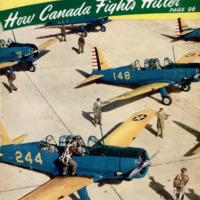 Popular Science Monthly, v. 140, n. 1, 1942
Popular Science Monthly, v. 140, n. 1, 1942

